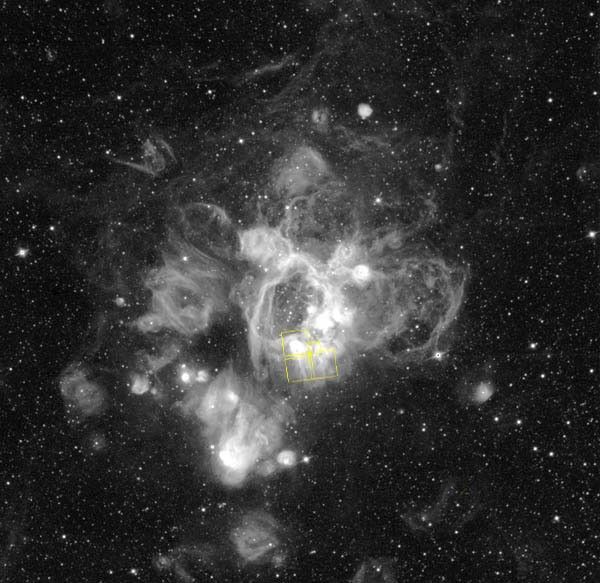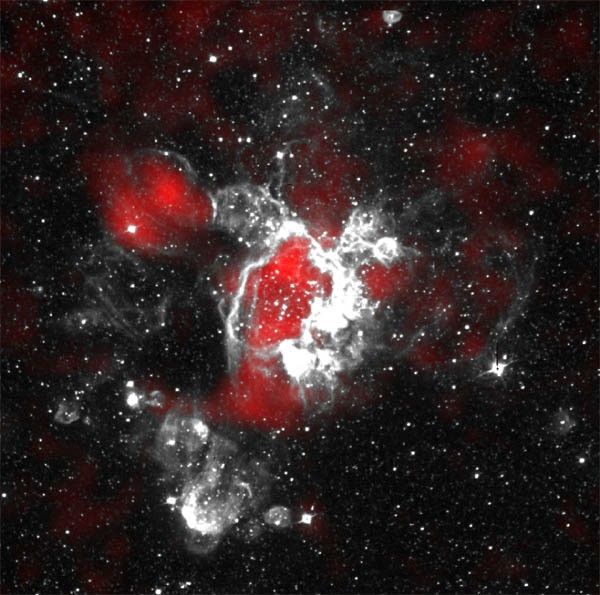1 min read
Gaseous Streamers from Nebula N44C Flutter in Stellar Breeze

Resembling the hair in Botticelli's famous portrait of the birth of Venus, softly glowing filaments stream from a complex of hot young stars. This image of a nebula, known as N44C, comes from the archives of NASA's Hubble Space Telescope (HST). It was taken with the Wide Field Planetary Camera 2 in 1996 and is being presented by the Hubble Heritage Project.
N44C is the designation for a region of glowing hydrogen gas surrounding an association of young stars in the Large Magellanic Cloud, a nearby, small companion galaxy to the Milky Way visible from the Southern Hemisphere.
N44C is peculiar because the star mainly responsible for illuminating the nebula is unusually hot. The most massive stars, ranging from 10-50 times more massive than the Sun, have maximum temperatures of 54,000 to 90,000 degrees Fahrenheit (30,000 to 50,000 degrees Kelvin). The star illuminating N44C appears to be significantly hotter, with a temperature of about 135,000 degrees Fahrenheit (75,000 degrees Kelvin)!
Ideas proposed to explain this unusually high temperature include the possibility of a neutron star or black hole that intermittently produces X-rays but is now "switched off."
On the top right of this Hubble image is a network of nebulous filaments that inspired comparison to Botticelli. The filaments surround a Wolf-Rayet star, another kind of rare star characterized by an exceptionally vigorous "wind" of charged particles. The shock of the wind colliding with the surrounding gas causes the gas to glow.
N44C is part of the larger N44 complex, which includes young, hot, massive stars, nebulae, and a "superbubble" blown out by multiple supernova explosions. Part of the superbubble is seen in red at the very bottom left of the HST image.
The data were taken in November 1996 with Hubble's Wide Field Planetary Camera 2 by Donald Garnett (University of Arizona) and collaborators and stored in the Hubble archive. The image was composed by the Hubble Heritage Team (STScI/AURA).
About the Object
- R.A. PositionR.A. PositionRight ascension – analogous to longitude – is one component of an object's position.05h 22m 12.55s
- Dec. PositionDec. PositionDeclination – analogous to latitude – is one component of an object's position.-67° 58' 31.8"
- ConstellationConstellationOne of 88 recognized regions of the celestial sphere in which the object appears.Dorado
- DistanceDistanceThe physical distance from Earth to the astronomical object. Distances within our solar system are usually measured in Astronomical Units (AU). Distances between stars are usually measured in light-years. Interstellar distances can also be measured in parsecs.About 50 kiloparsecs (160,000 light-years)
- DimensionsDimensionsThe physical size of the object or the apparent angle it subtends on the sky.The image is roughly 2.7 arcminutes (126 light-years or 38 parsecs) across.
About the Data
- Data DescriptionData DescriptionProposal: A description of the observations, their scientific justification, and the links to the data available in the science archive.
Science Team: The astronomers who planned the observations and analyzed the data. "PI" refers to the Principal Investigator.Principal Astronomers: D. Garnett (U. Arizona), Y.-H. Chu (U. Illinois), V. Galarza (Museum of Science and Industry, Chicago) - InstrumentInstrumentThe science instrument used to produce the data.HST>WFPC2
- Exposure DatesExposure DatesThe date(s) that the telescope made its observations and the total exposure time.November 13, 1996, Exposure Time: 1.3 hours
- FiltersFiltersThe camera filters that were used in the science observations.F502N ([O III]), F547M (Strömgren y), F656N (H-alpha), and F675W (R)
- Object NameObject NameA name or catalog number that astronomers use to identify an astronomical object.N44C
- Object DescriptionObject DescriptionThe type of astronomical object.H II Region in the Large Magellanic Cloud
- Release DateMay 9, 2002
- Science ReleaseGaseous Streamers Flutter in Stellar Breeze
- Credit

Related Images & Videos
Share
Details
Claire Andreoli
NASA’s Goddard Space Flight Center
Greenbelt, Maryland
claire.andreoli@nasa.gov






























